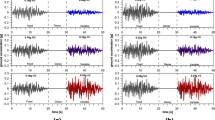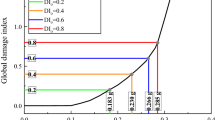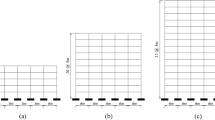Abstract
The city of Lorca (Spain) was hit on May 11th, 2011, by two consecutive earthquakes of magnitudes 4.6 and 5.2 M\(_\mathrm{w}\), causing casualties and important damage in buildings. Many of the damaged structures were reinforced concrete frames with wide beams. This study quantifies the expected level of damage on this structural type in the case of the Lorca earthquake by means of a seismic index \(I_{v}\) that compares the energy input by the earthquake with the energy absorption/dissipation capacity of the structure. The prototype frames investigated represent structures designed in two time periods (1994–2002 and 2003–2008), in which the applicable codes were different. The influence of the masonry infill walls and the proneness of the frames to concentrate damage in a given story were further investigated through nonlinear dynamic response analyses. It is found that (1) the seismic index method predicts levels of damage that range from moderate/severe to complete collapse; this prediction is consistent with the observed damage; (2) the presence of masonry infill walls makes the structure very prone to damage concentration and reduces the overall seismic capacity of the building; and (3) a proper hierarchy of strength between beams and columns that guarantees the formation of a strong column-weak beam mechanism (as prescribed by seismic codes), as well as the adoption of counter-measures to avoid the negative interaction between non-structural infill walls and the main frame, would have reduced the level of damage from \(I_{v}\) \(\,=\,\)1 (collapse) to about \(I_{v}\) \(\,=\,\)0.5 (moderate/severe damage).












Similar content being viewed by others
References
ACI Committee (2008) Building code requirements for structural concrete (ACI 318–08) and commentary. American Concrete Institute Edition, 318–08
Akiyama H (1985) Earthquake resistant limit-state for buildings. University of Tokyo Press, Tokyo
Akiyama H (2003) Metodología de proyecto sismorresistente de edificios basada en el balance de energía. Ed Reverté SA, Barcelona
Applied Technology Council (1996) Seismic evaluation and retrofit of concrete buildings, Report ATC-40. Applied Technology Council, Redwood City, California
Architectural Institute of Japan AIJ (1994) Structural design guidelines for reinforced concrete buildings. Architectural Institute of Japan, Tokyo (in English)
Baber TT, Noori MN (1985) Random vibration of degrading, pinching systems. J Eng Mech 111(8):1010–1026
Benavent-Climent A (2007) Seismic behavior of RC wide beam-column connections under dynamic loading. J Earthq Eng 11:493–511
Benavent-Climent A (2011a) An energy-based method for seismic retrofit of existing frames using hysteretic dampers. Soil Dyn Earthq Eng 31:1385–1396
Benavent-Climent A (2011b) A seismic index method for vulnerability assessment of existing frames: application to RC structures with wide beams in Spain. Bull Earthq Eng 9(2):491–517. doi:10.1007/s10518-010-9200-z
Benavent-Climent A, Pujades LG, López-Almansa F (2002) Design energy input spectra for moderate-seismicity regions. Earthq Eng Struct Dyn 31:1151–1172
Benavent-Climent A, Akiyama H, López-Almansa F, Pujades L (2004) Prediction of ultimate earthquake resistance of gravity-load designed RC buildings. Eng Struct 26:1103–1113
Benavent-Climent A, Cahís X, Zahran R (2009) Exterior wide beam-column connections in existing RC frames subjected to lateral earthquake loads. Eng Struct 34:1414–1424
Benavent-Climent A, Cahis X, Vico JM (2010) Interior wide beam-column connetions in existing RC frames subjected to lateral earthquake loading. Bull Earthq Eng 8:401–420
Benavent-Climent A, Donaire-Avila J, Escobedo A, Oliver-Saiz E, Ramírez-Márquez AL, Feriche M (2012) Damage assessment on building structures subjected to the recent near-fault earthquake in Lorca (Spain). 15th World Conference Earthquake Engineering IAEE
Bentz EC, Collins MP (2000) Response-2000. Reinforced Concrete Sectional Analysis using the Modified Compression Field Theory. University of Toronto, Toronto
Borzi B, Pinho R, Crowley H (2008) Simplified pushover-based vulnerability analysis for large-scale assess- ment of RC buildings. Eng Struct 30:804–820
Bouc R (1967) Forced vibration of mechanical systems with hysteresis. In: Proceedings of the 4th International Conference on Nonlinear Oscillations, Prague
Calvi GM (1999) A displacement-based approach for vulnerability evaluation of classes of buildings. J Earthq Eng 3(3):411–438
Calvi GM, Pinho R, Magenes G, Bommer JJ, Restrepo-Vélez LF, Crowley H (2006) Development of seismic vulnerability assessment methodologies over the past 30 years. ISET J Earthq Technol 43(3):75–104
Cosenza E, Manfredi G, Polese M, Verderame GM (2005) A multi-level approach to the capacity assessment of existing RC buildings. J Earthq Eng 9(1):1–22
Decanini LD, Mollaoli F, Oliveto G (1995) Observations and lessons learned from the earthquake of the 12th December 1990 in south-east Sicily. In: Proceedings of the 10th European Conference on Earthquake Engineering and Structural Dynamics, Vienna
Decanini LD, Mollaioli F (1998) Formulation of elastic earthquake input energy spectra. Earthq Eng Struct Dyn 27(12):1503–1522
Decanini L, Mollaioli F (2001) An energy-based methodology for the assessment of the seismic demand. Soil Dyn Earthq Eng 21:113–137
Decanini LD, Mollaioli F (2001) An energy-based methodology for the assessment of seismic demand. Soil Dyn Earthq Eng 21(2):113–137
Dolsek M, Fajfar P (2008) The effect of masonry infills on the seismic response of a four-storey reinforced concrete frame a deterministic assesment. Eng Struct 30:1991–2001
European Committee for Standardization (CEN) (2005) Eurocode 8: design of structures for earthquake resistance-part 3: assessment and retrofitting of buildings European Standard EN 1998–3:2005. Brussels, European Committee for Standardization
Fajfar P (1992) Equivalent ductility factors taking into account low-cycle fatigue. Earthq Eng Struct Dyn 21:837–848
Fajfar P, Gaspersic P (1996) The N2 method for the seismic damage analysis of RC buildings. Earthq Eng Struct Dyn 25:31–46
Fajfar P, Vidic T (1994) Consistent inelastic design spectra: hysteretic and input energy. Earthq Eng Struct Dyn 23:523–537
Fomento Ministerio (1998) Instrucción de Hormigón Estructural (EHE-98). Cent Publicaciones Minist de Fom de Esp, Madrid
Fomento Ministerio (2003) Norma de construcción sismorresistente: parte general y edificación (NCSE-02). Cent Publicaciones Minist de Fom de Esp, Madrid
Grupo Arktec SA (2010) Tricalc 7.1 Cálculo de Estructuras Tridimensionales. Ed Arktec SA, Madrid
Housner GW (1956) Limit design of structures to resist earthquakes. In: Proceedings of the 1st World Conference on Earthquake Engineering. Berkeley
IGME (2011) Informe Geológico Preliminar del Terremoto de Lorca del 11 de Mayo del año 2011 5.1 Mw. Instit Geol y Min de Esp, Madrid (in Spanish)
Mancilla F, Ammon CJ, Herrmann RB, Morales J (2002) Faulting parameters of the 1999 Mula earthquake, southeastern Spain. Tectonophysics 354:139–155
Ministerio de Obras, Publicas, T y M A (1974) Norma Sismorresistente PDS-1/1974. Cent de Publ Minist de Obras Públicas, T y M A, Madrid
Ministerio de Obras Públicas y Transportes (1991) Instrucción para el proyecto y la ejecución de obras de hormigón en masa o armado (EH-91). Cent de Publicaciones Minist Obras Públicas y Transp, Madrid
Ministerio de Obras, Publicas, T y M A (1995) Norma de Construcción Sismorresistente, Parte General y de Edificación (NCSE-94). Servic de Publ del Minist de Obras Públicas, T y M A, Madrid
Mollaioli F, Bruno Decanini L, Saragoni R (2011) Correlations between energy and displacement demands for performance-based seismic engineering. Pure Appl Geophys 168:237–259
Navarro M, García-Jerez JA, Alcalá FJ, Vidal F, Enomoto T, Luzón F, Creus C (2008) VS30 structure of Lorca town (SE Spain) from ambient noise array observations. 31st General Assembly of the European Seismological Commission ESC 2008. Hersonissos, Crete, Greece, 7–12 Sept 2008
Newmark NM, Hall WJ (1982) Earthquake spectra and sesign. Earthquake Engineering Research Institute, Oakland
Park YJ, Reinhorn AM, Kunnath SK (1987) IDARC: inelastic damage analysis of reinforced concrete frame-shear wall structures. Technical Report NCEER-87-0008 State University of New York, Buffalo
Park YJ, Ang AHS (1985) Mechanistic seismic damage model for reinforced concrete. J Struct Eng 111(4):722–739
Pujol S, Benavent-Climent A, Rodríguez ME, Smith-Pardo JP (2008) Masonry infill walls: an effective alternative for seismic strengthening of low-rise reinforced concrete building structures. In: Proceedings of the 14th world conference of earthquake engineering
Scales WGM (1998) European macroseismic scale. GeoForschungsZentrum, Postdam
Sezen H, Moehle P (2006) Seismic tests of concrete columns with light transverse reinforcement. Am Concr Inst 103(6):842–849
Sucuoglu H, Nurtug A (1995) Earthquake ground motions characteristics and seismic energy dissipation. Earthq Eng Struct Dyn 24(9):1195–1213
Teran-Gilmore A (1998) A parametric approach to performance-based numerical seismic design. Earthq Spectra 14(3):501–520
Uang CM, Bertero VV (1990) Evaluation of seismic energy in structures. Earthq Eng Struct Dyn 19:77–90
Vamvatsikos D, Cornell A (2002) Incremental dynamic analysis. Eathq Eng Struct Dyn 31:491–514
Vissers RLM, Meijninger BML (2011) The 11 May 2011 earthquake at Lorca (SE Spain) viewed in a structural-tectonic context. Solid Earthq 2:199–204
Acknowledgments
This work received financial support from the Spanish Government under project BIA2011-26816 and from the European Union (FEDER).
Author information
Authors and Affiliations
Corresponding author
Rights and permissions
About this article
Cite this article
Benavent-Climent, A., Escobedo, A., Donaire-Avila, J. et al. Assessment of expected damage on buildings subjected to Lorca earthquake through an energy-based seismic index method and nonlinear dynamic response analyses. Bull Earthquake Eng 12, 2049–2073 (2014). https://doi.org/10.1007/s10518-013-9513-9
Received:
Accepted:
Published:
Issue Date:
DOI: https://doi.org/10.1007/s10518-013-9513-9




